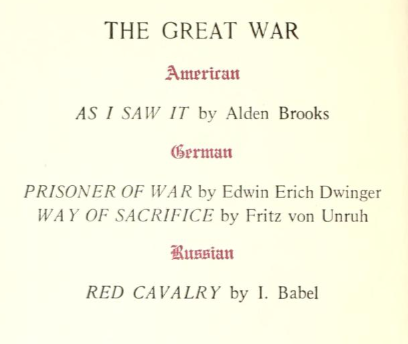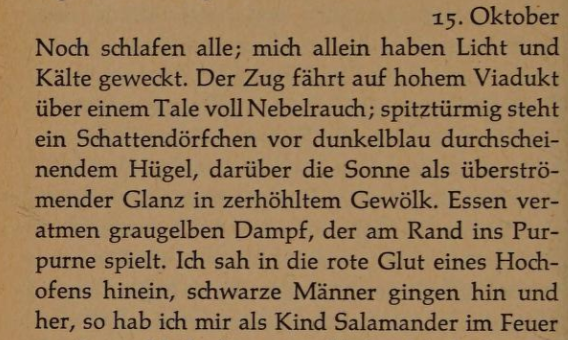Hans Carossa (1878-1956) volunteered in the First World War as an army physician for the German army; as his name suggests, he was of Italian descent, but was born and raised in Germany.

Hans Carossa
Already a poet before the War, and later a novelist, Carossa’s memoir Rumänisches Tagebuch (1924; trans. 1929 as A Roumanian Diary) follows his military experiences in Romania. The work was translated by the Scottish author Willa Muir under her pseudonym Agnes Neill Scott; she would also translate Carossa’s Verwandlungen einer Jugend (1928; trans. 1931 as Boyhood and Youth) and Doctor Gion (1931; trans. 1933). Highlighting its position in the War Books Boom, the US edition (Knopf, 1930) advertises other American, German and Russian books on the Great War on the page facing the title page.

Advertising other War Books Boom books in A Roumanian Diary (Knopf, 1930)
A Roumanian Diary is a remarkably detailed record of his experiences during the Romanian Campaign from 4 October to 15 December 1916. This was shortly after Romania had entered the war in response to an Allied ultimatum, on 27 August 1916. The country had previously been neutral. The Campaign lasted from August 1916 until December 1917 when, following Russia’s withdrawal from the conflict due to the October Revolution, Romania also withdrew; it briefly rejoined the War on 10 November 1918.
Carossa’s diary entries detail his travels with his regiment and his experience of censoring their outgoing letters. He includes his recollections of and reflections on several letters written by a soldier named Glavina, who ‘often writes such wonderful letters to his friends’ (p. 9). Carossa appreciates in Glavina a sensitivity to poetry, and a lyrical use of language, manifested in descriptions such as ‘“The world, rough, raw, and monstrous as it is—I live in it as in a thin and gaudily iridescent soap bubble, holding my breath to keep from bursting it’ (p. 58). Glavina’s death from a seemingly insignificant wound (p. 132) makes him a totemic figure to whom Carossa returns.
A Roumanian Diary was the first of Carossa’s writings to gain popularity outside of Germany. It was described by Lambert Davis in The Virginia Quarterly Review as ‘one of the few spiritual records that have come out of the War’, going on to state that Carossa’s ‘descriptions of warfare in the snow-bound Transylvanian mountains are among the most striking in war literature’ (p. 638).
Carossa would win the Swiss-based Gottfried Keller Prize (1931) and Germany’s prestigious Goethe Prize (1938). The award at this moment in Germany points to his problematic position in that nation’s literature. He did not leave Germany in the late 1930s as other German intellectuals chose or were forced to. He was championed by the Nazi regime, and was included by Goebbels on the September 1944 list of artists and cultural figures exempted from military service. Likely as a consequence, his later work attracted less interest beyond Germany, although he regained his popularity there.
Ray Thomson
(edited by Andrew Frayn)
Works Cited
Hans Carossa, A Roumanian Diary, trans. by Agnes Neill Scott [Willa Muir] (London: Martin Secker, 1929)
Lambert Davis, ‘Armageddon—Twelve Years After’, Virginia Quarterly Review, 6.4 (1930), 630-40 <https://www.jstor.org/stable/26433678> [accessed 14 June 2024]

Leave a Reply